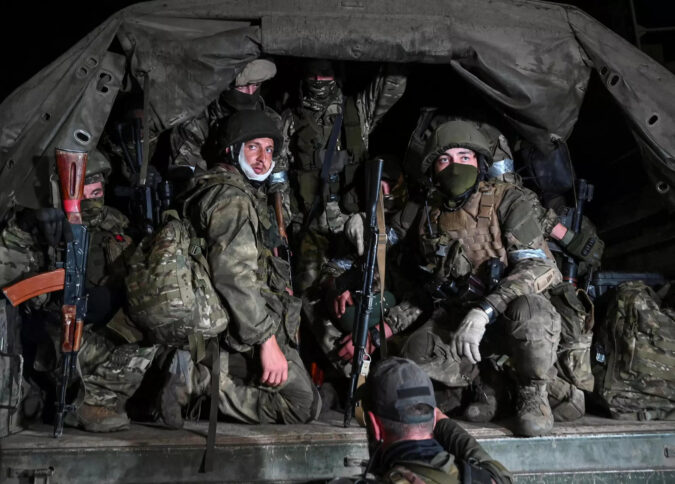On June 24, as Yevgeny Prigozhin’s rebel Wagner forces advanced towards Moscow, a group of military vehicles took an eastern diversion towards a fortified Russian army base believed to house nuclear weapons, Reuters reported after interviews with local residents and going through videos posted online.
However, once the Wagner fighters reach more rural regions, the surveillance trail goes cold – about 100 km from the nuclear base, Voronezh-45, the Reuters said.
The operation and security of the nuclear facility Voronezh-45 are entrusted to military unit number 14254, which falls under the purview of the Russian defense ministry’s 12th Main Directorate. This directorate is responsible for safeguarding Russia’s arsenal of nuclear weapons. Information available on the Russian defense ministry’s website and from publicly accessible records confirms the existence of the facility. However, the specific contents stored at Voronezh-45 are treated as a highly classified secret. Russia has not officially acknowledged the presence of nuclear weapons at the facility, and knowledge of their existence has primarily surfaced through reports from foreign scientists.
In an interview with Reuters, Ukraine’s head of military intelligence, Kyrylo Budanov, claimed that the Wagner fighters reached the nuclear base with the intention of acquiring small Soviet-era nuclear devices to escalate their mutiny. According to Budanov, the sole obstacle preventing the Wagner fighters from accessing nuclear weapons was the closed doors of the nuclear storage facility. “The doors of the storage were closed and they didn’t get into the technical section,” he said.
However, western officials have maintained that Russia’s nuclear arsenal was never at risk during the uprising.
Wagner commanders met Putin after mutiny, pledged loyalty
Meanwhile, a senior government spokesman revealed on Monday that just five days after a brief uprising, Yevgeny Prigozhin, the leader of the mercenary group known as Wagner, and his commanders met with Russian President Vladimir Putin and expressed loyalty to the government. The meeting, which lasted three hours, took place on June 29 and involved discussions about Wagner’s actions in Ukraine and the recent revolt.
During the meeting, the commanders presented their perspective on the events and emphasized their unwavering support for Putin as the head of state and commander-in-chief. They also reiterated their readiness to continue fighting for their homeland. Kremlin spokesman Dmitry Peskov confirmed the meeting, highlighting the commanders’ commitment to the government.
The fact that Putin held a face-to-face meeting with Prigozhin, whom he had initially denounced as a traitor during the uprising, is a significant development. The criminal case against Prigozhin for rebellion was subsequently dropped. However, Prigozhin has not commented on the meeting, and his future remains uncertain. It is possible that he may still face prosecution for financial misconduct or other charges, as the details of such negotiations often remain undisclosed.
(With inputs from agencies)
However, once the Wagner fighters reach more rural regions, the surveillance trail goes cold – about 100 km from the nuclear base, Voronezh-45, the Reuters said.
The operation and security of the nuclear facility Voronezh-45 are entrusted to military unit number 14254, which falls under the purview of the Russian defense ministry’s 12th Main Directorate. This directorate is responsible for safeguarding Russia’s arsenal of nuclear weapons. Information available on the Russian defense ministry’s website and from publicly accessible records confirms the existence of the facility. However, the specific contents stored at Voronezh-45 are treated as a highly classified secret. Russia has not officially acknowledged the presence of nuclear weapons at the facility, and knowledge of their existence has primarily surfaced through reports from foreign scientists.
In an interview with Reuters, Ukraine’s head of military intelligence, Kyrylo Budanov, claimed that the Wagner fighters reached the nuclear base with the intention of acquiring small Soviet-era nuclear devices to escalate their mutiny. According to Budanov, the sole obstacle preventing the Wagner fighters from accessing nuclear weapons was the closed doors of the nuclear storage facility. “The doors of the storage were closed and they didn’t get into the technical section,” he said.
However, western officials have maintained that Russia’s nuclear arsenal was never at risk during the uprising.
Wagner commanders met Putin after mutiny, pledged loyalty
Meanwhile, a senior government spokesman revealed on Monday that just five days after a brief uprising, Yevgeny Prigozhin, the leader of the mercenary group known as Wagner, and his commanders met with Russian President Vladimir Putin and expressed loyalty to the government. The meeting, which lasted three hours, took place on June 29 and involved discussions about Wagner’s actions in Ukraine and the recent revolt.
During the meeting, the commanders presented their perspective on the events and emphasized their unwavering support for Putin as the head of state and commander-in-chief. They also reiterated their readiness to continue fighting for their homeland. Kremlin spokesman Dmitry Peskov confirmed the meeting, highlighting the commanders’ commitment to the government.
The fact that Putin held a face-to-face meeting with Prigozhin, whom he had initially denounced as a traitor during the uprising, is a significant development. The criminal case against Prigozhin for rebellion was subsequently dropped. However, Prigozhin has not commented on the meeting, and his future remains uncertain. It is possible that he may still face prosecution for financial misconduct or other charges, as the details of such negotiations often remain undisclosed.
(With inputs from agencies)
